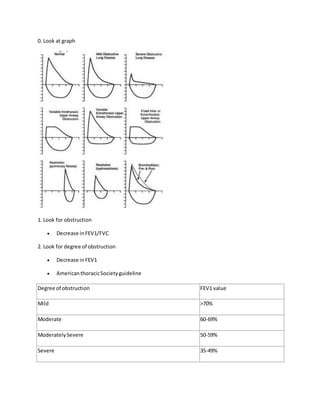More Related Content
Similar to Step by step guide in reading PFT
Similar to Step by step guide in reading PFT (7)
More from meducationdotnet
More from meducationdotnet (20)
Step by step guide in reading PFT
- 1. 0. Look at graph
1. Look for obstruction
Decrease inFEV1/FVC
2. Look for degree of obstruction
Decrease inFEV1
AmericanthoracicSocietyguideline
Degree of obstruction FEV1 value
Mild >70%
Moderate 60-69%
ModeratelySevere 50-59%
Severe 35-49%
- 2. VerySevere <35%
3. Look for significantBDchanges - Indicative of asthma
>12% or 200mL change
4. Look for restriction(Note:restrictive diseaserequiresdecreaseinbothFVCandTLC)
Decrease inFVC
Degree of restriction FVCvalue
Mild 60-80%
Moderate 50-60%
Severe <50%
5. Look at DLCO - indicatesproblemsingasexchange toblood
Degree of gas exchange DLCO value
Mild >60%
Moderate 40-60%
Severe <40%
6. If decrease inDLCOlookat KCO
DLCO isnot accurate
KCO- calibratedwithalveolarvolume
Asthmatic- eithernormal DLCOor low DLCO but normal KCO
Emphysema- lowDLCO and low KCO
7. Look for gas trappingandhyperinflation
Gas trapping- increase inRV and/ordecrease inFVC
Hyperinflation - increase inTLC
- 3. 8. Look at MIP/MEP (afterrestrictionisconfirmed)
Decrease inMIP/MEP indicatesneuromusculardisease
Normal MIP/MEP - Obesity,chestwall
NOTE: normal FVCand normal TLC can indicate non-specificpattern(70% obstructionand30%
restrictive disease)
